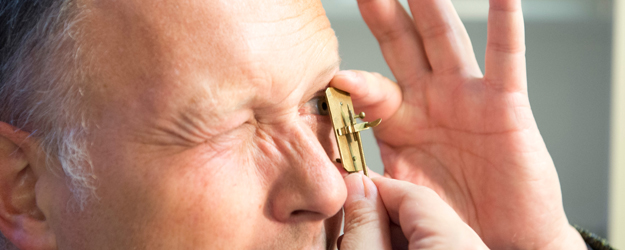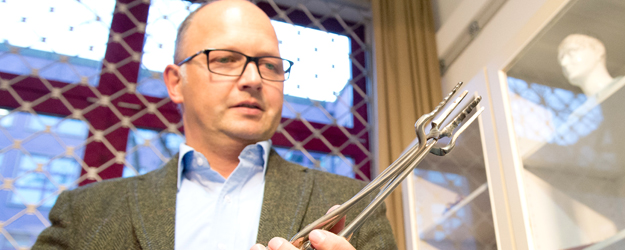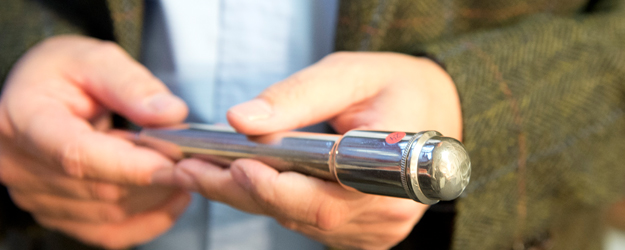10 January 2014
There is a small but fine collection of various historical medical objects in the library of the Institute of History, Philosophy, and Ethics of Medicine of the Mainz University Medical Center. Professor Norbert W. Paul knows his way around here. The Director of the Institute tells some of the stories that lie behind the exhibits.
Professor Norbert W. Paul removes a tiny device from the display cabinet. A finely crafted screw mechanism is fitted on the short brass plate. This makes it possible to adjust a pin in front of a small hole in the plate. "Just look through it," encourages the Director of the Institute of the History, Philosophy, and Ethics of Medicine. "Hold it very close to your eyes and toward the light." There is not much to see. Semi-transparent objects appear to float through the field of view. "Those are only detached fragments of your vitreous body," dismisses Paul.
"This in fact is the first microscope of Antoni van Leeuwenhoek," explains the professor. But where is the lens for this device? "In the small hole. It was not possible to grind large lenses back in the 17th century." So the Dutch constructor of the microscope had to be content with a millimeter-sized piece of glass. He speared the objects that he wanted to observe on the pin. "With that you have an approximate 200-fold magnification,"says Paul.
A random collection
The Medical History Collection of the Institute of History, Philosophy, and Ethics at the University Medical Center fits into a few cabinets. It is one of the smaller collections at Johannes Gutenberg University Mainz (JGU), but it is still rich in variety. Surgical instruments sparkle almost like new, old spectacles glisten, and a marble human head shines in white. In between, there are rather inconspicuous old medicine packages – and this little microscope. Although it is only a replica, it is still an excellent work. "A real microscope of this kind is beyond price," says Paul.
The collection resides in a basement room in the building of the Mainz University Medical Center. Much has accumulated over the years. Almost all the exhibits are original. The microscope is one of the few exceptions. The objects come from doctors or from neighboring university hospitals. "Some things were also purchased in the past," tells Paul. "But of course we are not a museum; this is more of a random collection. There are three medical history museums in Germany – a major one in Ingolstadt and two smaller ones in Berlin and Bochum – and we are in contact with all of them. If we get something special, which is not available there, then we forward it on loan."
Many objects, however, have remained in Mainz. Paul shows and tells amazing, sometimes gruesome stories. The professor again takes something from the display cabinet. Some delivery forceps from the 19th century lie there, the sight of which may well trigger an uneasy feeling in the lower abdomen area for the layman.
The foreceps of the gynecologist
Paul brings a similarly large, but somewhat differently designed device from the cabinet. Four metal gripper arms can easily be adjusted. "This is a device which was used for assisting in abortions." The gynecologist used it to grab the fetus that had already been killed. "He smashed the skull with the forceps first, so that the fetus could fit through the birth canal better." The device was used for medically indicated abortions.
The Medical History Collection is a place of contrasts. Next, Paul shows a life awakener. The device was brought to the people after 1840 by the Westphalian inventor Carl Baunscheidt. At the time, you could find it in nearly every household," says Paul. The life awakener looks like a slender flashlight. However, it gives no light. When pressed, a bundle of sharp needles emerges from the shaft.
The inventor suffered from rheumatoid arthritis and noticed, by chance, that a bee sting gave him relief. So he set out to imitate multiple stings. "He smeared a paste of essential oils on the needles." Consequently, many swore by the device. "It caused a furor."
Some items in the Medical History Collection seem like curiosities. But for Paul, they are important devices from medical practices of the past. And many, such as the delivery forceps, look already modern. Surgical instruments from about the 19th century, for example: "See, we already have knives like that today. And here is the classic bone saw."
Phrenology in porcelain
Paul also shows an early stethoscope. At the end of a wooden tube is a plate of ivory. "At the time, the patient was clothed when listening, especially women." But it was not about detecting a slight whistling of the bronchi. "This device was used primarily to diagnose tuberculosis."
Paul makes remarks on each exhibit, whether it is the martial-appearing dental equipment or the porcelain head, on whose skull dome all sorts of properties are listed. In the 18th century, the German brain researcher Franz Joseph Gall assumed that various characteristics were reflected in the shape of the head. The whole practice was called phrenology. "He thought that the especially developed areas of the brain made an impression on the skull from the inside."
The porcelain head and the other objects of the Medical History Collection are not hidden in the Institute of History, Philosophy, and Ethics of Medicine. They are a part of the library's portfolio, which also exhibits valuable books. Some lie open in adjacent display cases. Oil paintings of important physicians hang above them. Thus, the famous anatomist, Samuel Thomas Soemmerring, looks down at the visitor. He was a professor in Mainz in 1784. Georg Forster called him "Germany's Hippocrates."
What did he think of Gall's phrenology? What would he have thought of Baunscheidt's life awakener? Professor Norbert W. Paul could tell interesting stories about each object in the Medical History Collection, but this would go beyond the scope of this meeting. Thus, the display cabinets are closed, the light goes out, and Soemmerring disappears into the darkness.



